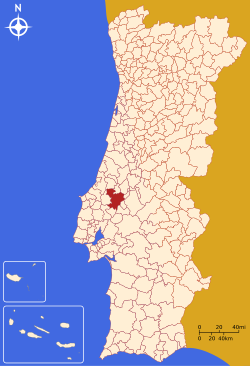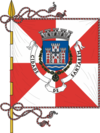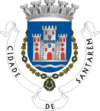Santarém, Portugal
| Santarém | |||
|---|---|---|---|
| Municipality | |||

Cabaças tower, formerly part of the city's fortifications.
|
|||
|
|||
 |
|||
| Coordinates: 39°14′N 08°41′W / 39.233°N 8.683°WCoordinates: 39°14′N 08°41′W / 39.233°N 8.683°W | |||
| Country |
|
||
| Region | Ribatejo | ||
| Subregion | Lezíria do Tejo | ||
| Intermunic. comm. | Lezíria do Tejo | ||
| District | Santarém | ||
| Parishes | 18 | ||
| Government | |||
| • President | Ricardo Gonçalves (PSD) | ||
| Area | |||
| • Total | 552.54 km2 (213.34 sq mi) | ||
| Population (2011) | |||
| • Total | 61,752 | ||
| • Density | 110/km2 (290/sq mi) | ||
| Time zone | WET/WEST (UTC+0/+1) | ||
| Website | http://www.cm-santarem.pt | ||
Santarém (Portuguese pronunciation: [sɐ̃tɐˈɾɐ̃j]) is a city and municipality located in the district of Santarém in Portugal. The population in 2011 was 61,752, in an area of 552.54 km². The population of the city proper was 29,929 in 2012.
The Mayor is Ricardo Gonçalves (PSD). The municipal holiday is March 19, day of São José.
Since prehistory, the region of Santarém has been inhabited, first by the Lusitani people, and then by the Greeks, Romans, Visigoths, Moors and later Portuguese Christians. Of the various legends related to the foundation of Santarém, the most famous tells of the Visigoth Saint Iria (or Irene), who was martyred in Tomar (Nabantia) and whose uncorrupted body reached Santarém. In her honour, the name of the town (then known by its Latin name Scalabis) would later be changed to Sancta Irene, from which Santarém would eventually be derived.
The foundation of the city is attributed to the Romans, who occupied the region in the 2nd century BC and named the city Scalabis. During the Roman period, Scalabis was an important commercial post in the mid-Tagus region, and was the administrative capital of one of the regions (Conventus Escalabitanus) of Lusitania. Julius Caesar creates in 61 a.c., a military camp in Santarém. The city takes at this time the designation of Scallabis Praesidium Iulium.
The III century crisis and the decline of the Western Roman Empire affected the civitas, and in the V century the town was conquered by the barbarians(vandals and alans). In 460, the Visigoths, led by Sunerico, gain the city and expelled the alans.
After the period of Visigoth domination, Santarém was taken in the 8th century by the Arabs, under whose rule the city became an important cultural centre. Important Arab personalities born in Santarém (or Shantarin, in Arabic) are the poet and historian Ibn Bassam (died 1147) and the poet Ibn Sara (1043–1123).
...
Wikipedia


